Charts of the Week
Current Economic Trends from 25 to 29 January 2021: electricity consumption, traffic of electronically tolled vehicles, registered unemployment, fiscal verification of invoices and other charts
The second wave of the epidemic severely affected especially some service activities, with turnover in accommodation and food service activities falling particularly sharply because of the containment measures. Turnover in trade also fell further in November due to the closure of some non-essential shops and other containment measures. With a partial opening, it started to recover in some segments in December, according to preliminary data. Data on the fiscal verification of accounts also point to a further improvement in January. The second wave did not have a noticeable impact on confidence and activity in construction and manufacturing, which is also indicated by electricity consumption and freight transport on Slovenian motorways. Electricity consumption in the last but one week in January was at the same level as a year earlier, while freight traffic lagged behind only slightly. With intervention measures still in place, the increase in the number of unemployed in January did not deviate significantly from the increases in previous years.
Electricity consumption, January 2021
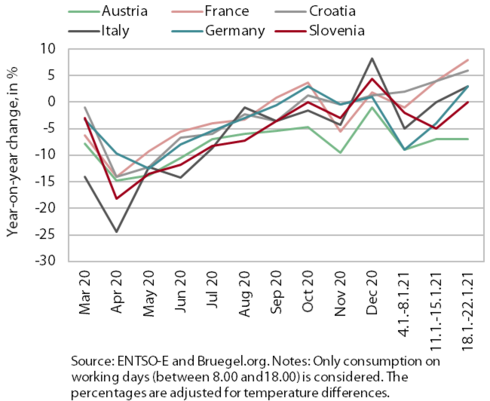
Electricity consumption in Slovenia in the penultimate week of January was at the same level as last year. Among Slovenia’s main trading partners, the largest year-on-year decline in consumption was recorded in Austria (7%), as in the entire period of the second wave of the epidemic. In other main trading partners, electricity consumption was higher than in the same period last year. In Germany, it was 3% higher year on year, after an almost 7% year-on-year decline in the first half of January. By the same percentage higher consumption was also recorded in Italy, while in Croatia and France it was 6% and 8% higher respectively.
Traffic of electronically tolled vehicles on Slovenian motorways, January 2021
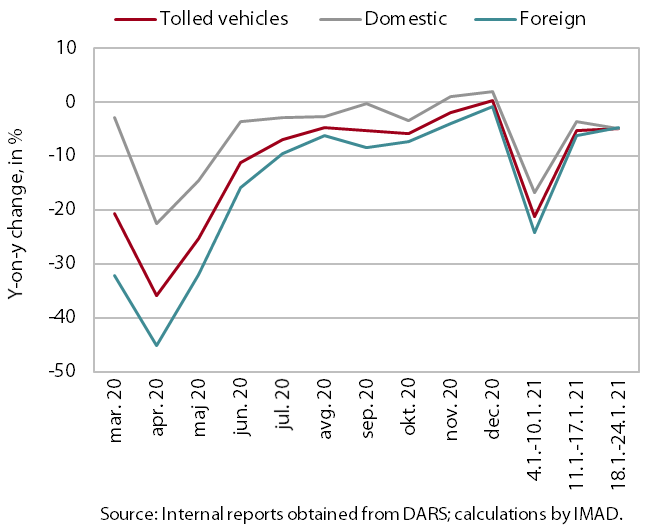
Freight traffic on Slovenian motorways in the penultimate week of January was somewhat lower than in the same period of the previous year. At the beginning of January, traffic was significantly lower year on year due to the impact of a less favourable distribution of public holidays and because of heavy snowfall in some neighbouring countries. In mid-January, the year-on-year decline decreased and remained at a similar level between 18 and 24 January (down 5%, the same for domestic and foreign vehicles). We estimate that the year-on-year lag during the second wave of the epidemic is to a great extent related to lower transshipment of goods in the Port of Koper and less to the containment measures in services.
Registered unemployment, January 2021
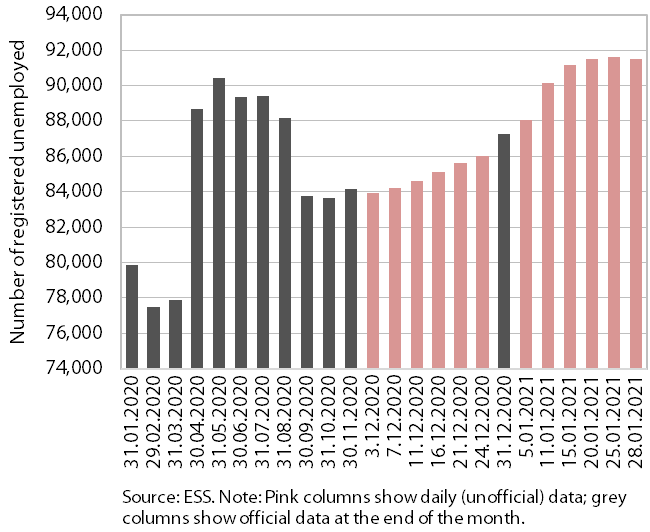
The number of registered unemployed persons rose moderately in January, particularly due to seasonal factors. Following a pronounced increase during the first wave of the epidemic, the number of registered unemployed persons was gradually falling from July to September after the adoption of intervention job retention measures and the lifting of restrictions. Between September and November, it remained roughly unchanged, before starting to rise moderately in December. Growth also continued at the beginning of this year – on 28 January, 91,505 persons were unemployed according to ESS unofficial (daily) data, which is 4.8% more than at the end of December and around 15% more than in the same period last year. Due to the retention of intervention measures, the increase in the number of unemployed persons in December and January did not deviate significantly from the increases in previous years – the increases at the end of last and the beginning of this year were again largely due to the fact that more fixed-term employment contracts typically expire in this period of the year.
Fiscal verification of invoices, January 2021
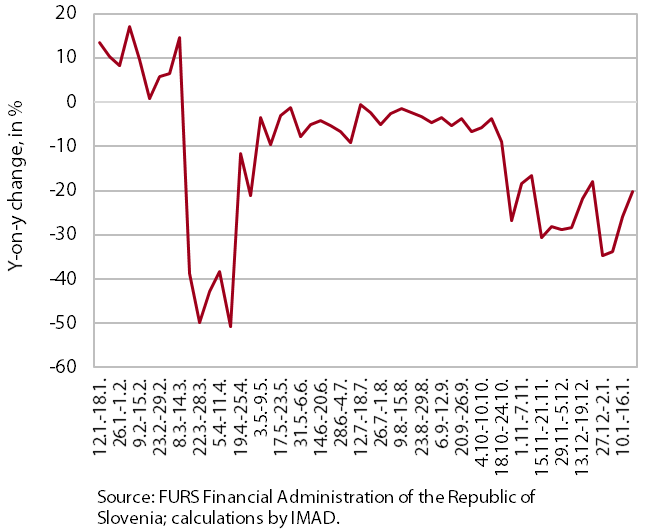
According to data on the fiscal verification of invoices, the year-on-year fall in turnover decreased in the middle of January. With the opening of some shops and activities, it decreased before the Christmas holidays and then increased markedly again around the turn of the year. By mid-January, the year-on-year fall was again smaller, mainly due to a smaller drop in turnover in all three main trade segments (the sale and repair of motor vehicles, wholesale trade and retail trade). The year-on-year lag in turnover remained largest in accommodation and travel agency activities.
Business tendency, January 2021
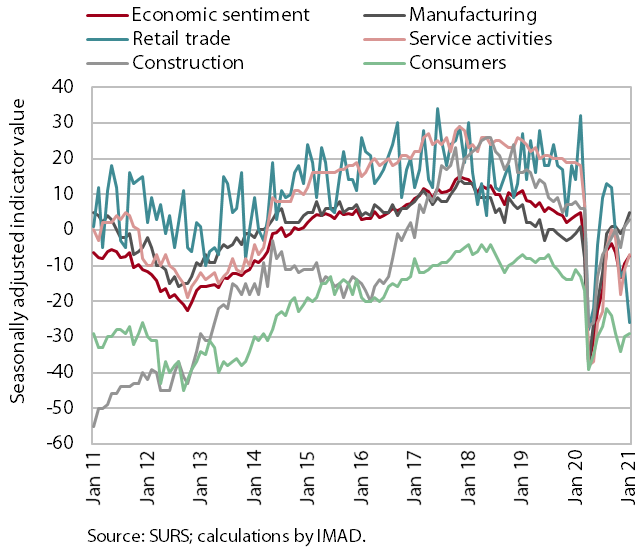
Economic sentiment improved in January for the second consecutive month, after deteriorating since the beginning of the second wave of the epidemic. Confidence in manufacturing improved further and was the highest in two years. Confidence in services also improved noticeably for the second month in a row (particularly due to expected demand), but remained considerably lower than a year earlier. A further strengthening of confidence was also recorded among consumers and in construction, which, along with manufacturing, remains one of the less affected sectors. However, the confidence indicator in retail trade deteriorated considerably after the improvement in December, but, as the confidence indicators in other activities, remained above the levels from the first wave of the epidemic.
Trade, November 2020
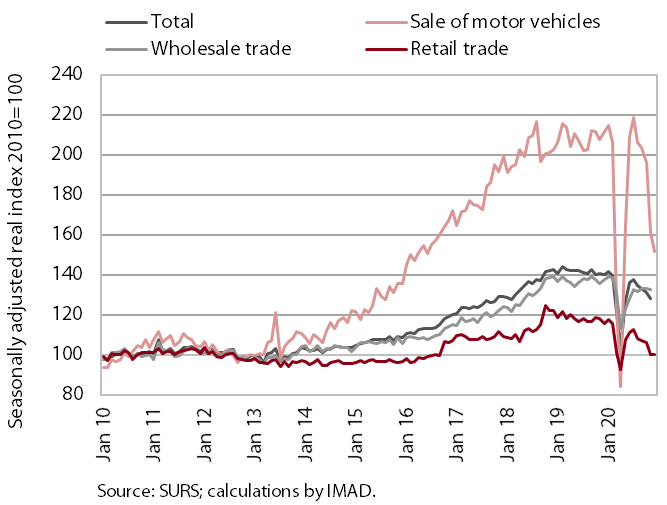
Turnover in trade declined further in November with the closure of some non-essential shops and other retention measures; with a partial opening, it improved in some sectors in December. In November, turnover dropped in all three main segments, the most in the sale of motor vehicle, where it had also fluctuated the most in previous months. Turnover in retail trade also decreased significantly. In this segment, turnover in the sale of non-food products dropped the most, particularly in the sale of clothing and footwear and furniture and household equipment. The already high sales via mail order or the internet strengthened further. In December, the further decline in non-food produces was interrupted with a temporary opening of some shops, according to preliminary data.
Market services, November 2020
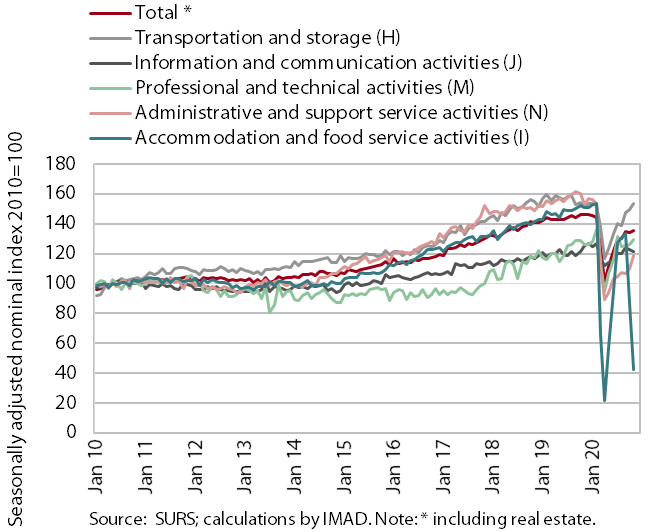
After a smaller decline in the previous month, turnover in market services strengthened in most services in November. Despite a further contraction in travel agencies, the strongest monthly growth in turnover continued in administrative and support service activities, mostly due to further growth in rental and leasing activities and office administrative and support activities. Turnover growth accelerated in professional and technical activities (especially in architectural and engineering services) and transportation (particularly road freight transport). In information and communication activities turnover fell somewhat again despite growth in exports of computer services. In accommodation and food service activities it more than halved with the closure of hotels and restaurants in November.
